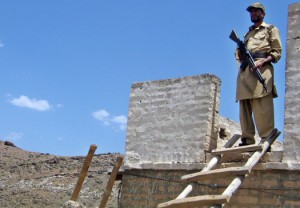South Waziristan — home of Baitullah Mehsud, the slain don of the Pakistani Taliban — is the next stop in Pakistan’s war on terror.
Though Washington has been encouraging an operation in the lawless Waziristan area since early summer, the Pakistan Army has decided to go into Mehsud country at a time of its choosing and based on its own reasoning. Pakistan’s largely American-funded counterinsurgency is, to a large extent, being conducted on Rawalpindi’s terms, not Washington’s. The probability of the Pakistan Army going beyond taking care of its own enemy in South Waziristan, the Tehreek-e Taliban Pakistan, and making an honest effort to go after America’s foes engaged in attacks on coalition forces in Afghanistan, is low.
Preparation for the operations began in June, when the Pakistan Army — aided by suspected American drone strikes — started “softening” the terrain with airstrikes and mortar fire and choking off the TTP’s supply routes into South Waziristan. The United States, armed with Pakistani intelligence and Predator drones, took out Baitullah Mehsud in a strike on August 5, which has been a considerable blow to the TTP’s cohesiveness.
Precision air and drone strikes have eliminated key TTP operatives and facilities, reducing the quality and scale of terrorist activity inside Pakistan. Operation Rah-e Rast, which targeted the TTP in the Malakand division, also in northwest Pakistan, and a series of smaller scale operations throughout the tribal areas, have reduced the TTP’s operational space. Much of its leadership is currently confined to the greater Waziristan area.
At the same time, the Pakistani government has been playing hardball with the Mehsud tribe, trying to get it to turn against the TTP. This effort, which includes attempts to form anti-TTP lashkars, has yielded limited success.
But the Pakistan Army apparently feels that now, as winter begins in Waziristan, is an opportune time to seriously debilitate the TTP. The local population in Mehsud country has been ordered by radio to evacuate the area; tens of thousands have left. Heavy ground operations could begin sometime in October. The window of opportunity is closing. As the New York Times’ Ismail Khan notes, the rugged region is generally hit by snow starting in late November.
The Pakistan Army, it is said, distinguishes between the “good” and “bad” Taliban. But such language mischaracterizes the decision making process in Rawalpindi. The Pakistan Army is a coherent, modern organization with a cold, rational outlook on its surrounding landscape. It is interested in furthering its strategic objectives. For the Pakistan Army, some Taliban groups can be seen as strategic assets, while others, such as the TTP, are more clearly enemies.
And so as the Pakistan Army heads into South Waziristan to give the TTP network a decisive blow, there is little likelihood that it will target the networks of commanders like Maulvi Nazir, Hafiz Gul Bahadur, and Jalaluddin Haqqani, all of whom chiefly target coalition forces in Afghanistan rather than the Pakistani state or military. Indeed, it is difficult to imagine that the Pakistan Army would begin operations in South Waziristan without the confidence that these three networks would not attack it in defense of the TTP.
The reasons for this are, in part, economic. It’s easier to target one group focused in a single area, rather than four or more groups each located on opposite ends of North and South Waziristan. But beyond this, the Pakistani military-intelligence establishment remains concerned with its security predicament in a post-America Afghanistan.
It would like to see a coherent and non-hostile government in Kabul that can, at the very least, serve as an energy and trade corridor from Gwadar and Karachi to the ancestral lands in Central Asia of Babur, the founder of the Mughal Empire. Rival India is emerging on the world stage, and Pakistan would like to restrain the growth of the Indian presence in its own backyard. Add to this the shared population and borders between the two countries, and it becomes clear that no country in the world is as impacted by developments in Afghanistan as is Pakistan.
Recent reports that the United States and NATO members have come to terms with another Karzai presidency have proven Pakistan’s contention that to shape events in Afghanistan, you need an allied Pashtun on top. Karzai is the least incapable of America’s Pashtuns. But Pakistan, whose relations with Karzai have improved in the past year, also has Afghan Pashtuns of its own, the most important of whom is Mullah Muhammad Omar, head of the Afghan Taliban. And with the Afghan Taliban ascendant, it is not realistic to expect Pakistan to turn against it and affiliated networks just yet. Why would the Pakistan Army ditch a rising Afghan Taliban for a sinking Karzai and his band of kleptomaniacs? The Pakistan army might see itself as betting on the winning horse in the long run.











November 23rd, 2009 at 10:38 PM
.